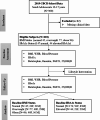Circulating fibroblast growth factor-21, Omentin-1, and betatrophin and their association with metabolic parameters in Saudi adolescents post 12-month lifestyle change program
- PMID: 40597046
- PMCID: PMC12220389
- DOI: 10.1186/s12887-025-05833-z
Circulating fibroblast growth factor-21, Omentin-1, and betatrophin and their association with metabolic parameters in Saudi adolescents post 12-month lifestyle change program
Abstract
Background: Fibroblast growth factor-21 (FGF21) and omentin-1 have been recognized as potent antidiabetic agents with potential hepatoprotective activity. The aim of this study was to evaluate the associations between betatrophin, hepatic FGF21 and omentin-1 as predictive markers of insulin resistance in adolescents who underwent a 12-month lifestyle change intervention program.
Methods: Prospective data of 218 Saudi adolescents (45 normal and 77 overweight, and 96 obese) (mean age = 15.1 ± 1.5 years and mean BMI = 35.1 ± 6.6 kg/m2) who participated in a 12-month lifestyle modification program were included. Baseline and follow-up data on anthropometrics and clinical data were collected. Serum levels of betatrophin, omentin-1, FGF-21 and 25(OH)D were assessed using commercially available assays. Analysis and comparisons were done according to varying levels of body mass index (BMI) and glycemic status.
Results: Results showed that betatrophin level decreased in the obese and prediabetic groups (p = 0.03, p = 0.002 respectively). There was a significant decrease in BMI in obese and overweight participants after the 12-month lifestyle modification program [35.1 ± 6.6 & 33.1 ± 7.5 and 26.6 ± 1.5 & 25.6 ± 2.3, p < 0.05 and p < 0.01 respectively]. Follow-up omentin1 was significantly elevated in overweight and obese individuals but no significant difference in omentin-1 in prediabetic group at follow-up was observed (p > 0.05).
Conclusion: We concluded that betatrophin levels had an inverse association with metabolic biomarkers omentin-1, FGF-21, and 25(OH)D after a 12-month lifestyle modification program. A healthy diet and exercise are associated with decreased betatrophin levels and improving glucose tolerance.
Keywords: Adolescents; Betatrophin; FGF-21; Obesity; Omentin-1; Prediabetic; Vitamin-D.
© 2025. The Author(s).
Conflict of interest statement
Declarations. Ethics approval and consent to participate: All subjects signed a written informed consent before their participation in the study, which was approved by the Ethical Review Board and abiding by the guidelines of the Helsinki Declaration. This study was approved by the Institutional Review Board (IRB) of the College of Medicine, King Saud University (KSU), Riyadh, Saudi Arabia (Ref. No. 23/0081/IRB-A). Participants as well as their respective parents or legal guardians were fully informed about the purpose and procedures of the study before giving assent and signing the informed consent form, respectively. Consent for publication: Not applicable. Competing interests: The authors declare no competing interests. Clinical trial number: Not applicable.
Figures



Similar articles
-
The interaction of vitamin D supplementation with Omentin-1 gene polymorphism on metabolic biomarkers, omentin-1 levels and anthropometric measures in women with prediabetes: A double-blind randomized controlled trial.Diabetes Obes Metab. 2025 Aug;27(8):4522-4536. doi: 10.1111/dom.16497. Epub 2025 Jun 11. Diabetes Obes Metab. 2025. PMID: 40497345 Clinical Trial.
-
Diet, physical activity and behavioural interventions for the treatment of overweight or obese children from the age of 6 to 11 years.Cochrane Database Syst Rev. 2017 Jun 22;6(6):CD012651. doi: 10.1002/14651858.CD012651. Cochrane Database Syst Rev. 2017. PMID: 28639319 Free PMC article.
-
Diet, physical activity and behavioural interventions for the treatment of overweight or obese adolescents aged 12 to 17 years.Cochrane Database Syst Rev. 2017 Jun 22;6(6):CD012691. doi: 10.1002/14651858.CD012691. Cochrane Database Syst Rev. 2017. PMID: 28639320 Free PMC article.
-
Physical activity, diet and other behavioural interventions for improving cognition and school achievement in children and adolescents with obesity or overweight.Cochrane Database Syst Rev. 2018 Mar 2;3(3):CD009728. doi: 10.1002/14651858.CD009728.pub4. Cochrane Database Syst Rev. 2018. PMID: 29499084 Free PMC article.
-
Physical activity, diet and other behavioural interventions for improving cognition and school achievement in children and adolescents with obesity or overweight.Cochrane Database Syst Rev. 2018 Jan 29;1(1):CD009728. doi: 10.1002/14651858.CD009728.pub3. Cochrane Database Syst Rev. 2018. Update in: Cochrane Database Syst Rev. 2018 Mar 02;3:CD009728. doi: 10.1002/14651858.CD009728.pub4. PMID: 29376563 Free PMC article. Updated.
References
-
- Abu-Farha M, Abubaker J, Tuomilehto J. ANGPTL8 (betatrophin) role in diabetes and metabolic diseases. Diab/Metab Res Rev. 2017;33(8):e2919. - PubMed
-
- Wu S, Gao H, Ma Y, Fu L, Zhang C, Luo X. Characterisation of betatrophin concentrations in childhood and adolescent obesity and insulin resistance. Pediatr Diabetes. 2016;17(1):53–60. - PubMed
MeSH terms
Substances
Grants and funding
- RSP2024R21/Researchers Supporting Project at King Saud University
- RSP2024R21/Researchers Supporting Project at King Saud University
- RSP2024R21/Researchers Supporting Project at King Saud University
- RSP2024R21/Researchers Supporting Project at King Saud University
- RSP2024R21/Researchers Supporting Project at King Saud University
LinkOut - more resources
Full Text Sources

